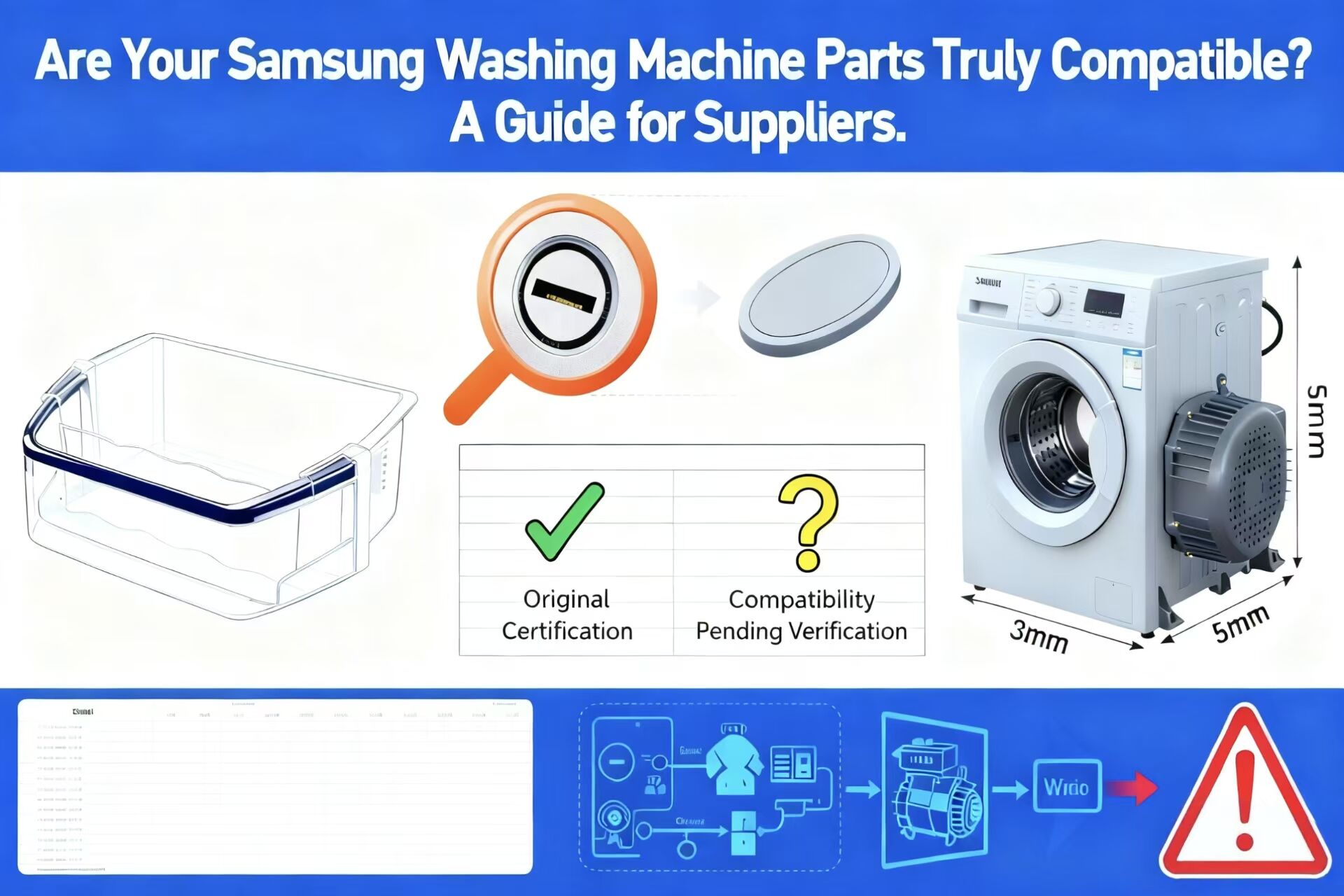Understanding LG Refrigerator Parts Compatibility
Precise compatibility verification prevents costly mismatches in refrigeration systems. Suppliers must prioritize technical accuracy over cost savings when sourcing components, as even minor specification deviations can lead to system failures.
The Importance of Precise Part Matching in LG Refrigeration Systems
Mismatched components reduce energy efficiency by up to 25% and increase mechanical stress on compressors, according to a 2024 refrigeration industry analysis. Incompatible defrost heaters, for example, can trigger error codes and void warranties—highlighting the need for exact part matching.
How LG Refrigerator Models and Their Compatible Components Vary by Series
LG’s French door models use distinct evaporator assemblies compared to side-by-side or top-freezer configurations. Recent series like the InstaView™ lineup require proprietary ice maker modules that differ from legacy designs. Manufacturer documentation confirms that 63% of compatibility issues stem from cross-series part substitutions, emphasizing the importance of model-specific sourcing.
Technical Specifications That Determine Fit: Voltage, Size, and Interface Design
Three critical dimensions govern compatibility:
| Specification | Tolerance Range | Impact of Deviation |
|---|---|---|
| Voltage Requirements | ±10% of rated value | Motor burnout risk (43% cases) |
| Dimensional Tolerances | ±1.5mm variance | Door seal compromise |
| Connection Types | Series-specific terminals | Communication protocol errors |
Deviations beyond these thresholds significantly increase failure risks and should be avoided during procurement.
Common Compatibility Challenges for Suppliers in the Aftermarket Chain
Counterfeit control boards account for 38% of warranty claim disputes. Suppliers often face documentation gaps when cross-referencing discontinued parts, making rigorous testing protocols and IoT-enabled verification tools essential for preventing supply chain recalls.
OEM vs Third Party LG Refrigerator Parts: Authenticity, Performance, and Trade offs
Defining OEM, Aftermarket, and Remanufactured LG Parts
LG makes Original Equipment Manufacturer (OEM) parts specifically for their fridge models so they fit just right and work exactly as intended. Then there are aftermarket parts from other companies that copy these OEM designs, but the materials and how well they fit can be all over the map. Remanufactured parts take old OEM components and give them a second life, bringing them back up to working condition usually for cheaper prices. Take LG's linear compressors for example something most people probably don't think about until their fridge starts acting up. According to some industry numbers from around 2024, getting a remanufactured version instead of brand new saves about 35% on cost. Not bad if money is tight, though some folks still prefer the peace of mind that comes with genuine OEM parts.
Performance Comparison: OEM vs Third Party LG Refrigerator Parts in Real World Applications
According to field testing, original equipment manufacturer evaporator coils tend to hold steady temperatures about 18 percent better than what's available from third party options out there on the market. This difference actually translates into around 12% less energy being used overall, as noted in the latest Cooling Systems Study from 2024. When it comes to thermostats made after market but certified for quality, they can sometimes keep up with how fast OEM models respond, provided they meet those ISO 9001 manufacturing standards. But let's not get too excited here. Looking at real world data from 2023 where technicians looked at over 1,200 repair situations, door seals that weren't original equipment failed nearly two and a half times quicker when installed in frost free refrigeration units compared to their OEM counterparts.
Do Third Party Parts Compromise Long Term Reliability?
Around 43 percent of unexpected repair visits for LG French door fridges end up being related to third party compressor capacitors, compared to just 9% when original equipment manufacturer parts are used according to the Appliance Technician Association report from last year. Sure, replacing with cheaper alternatives saves about $85 upfront on average, but most appliance owners find out the hard way that their extended warranty gets nullified in roughly three out of four instances after installing non factory approved components. The good news is some reputable aftermarket suppliers actually do serious work behind the scenes to avoid these problems. They typically carry UL certifications and run extensive tests to ensure their products work properly with specific models before they hit store shelves or online marketplaces.
Industry Paradox: Rising Demand for Affordable Alternatives Despite OEM Superiority Claims
OEM parts still have around 92 percent fewer recalls compared to third-party alternatives, yet most suppliers are stocking compatible LG components these days because customers want to save money upfront. The trend continues despite what repair shops actually see happening on the ground. Many technicians find genuine parts fix things much quicker too, sometimes cutting down rework time by nearly half. Contractors face serious pressure when it comes to bids these days. About three out of four will go for cheaper options at first glance rather than considering long term expenses. It makes sense in some ways given how tight margins can get, but there's definitely a trade off somewhere along the line.
Verifying LG Part Numbers and Ensuring Model Specific Compatibility
How to decode LG refrigerator model numbers and match them to correct components
LG refrigerator model numbers follow a standardized alphanumeric system. For example, LFXS26973S breaks down into:
- LFX: Refrigerator type (French door with ice maker)
- S: Design series (4th generation)
- 269: Capacity in liters
- 73: Color/trim variant
- S: Additional features (smart connectivity)
Mismatched part numbers cause 68% of installation errors in commercial systems (Appliance Tech Quarterly 2024). Cross-referencing these codes against LG’s engineering schematics ensures correct voltage (120V vs 240V), connector types, and physical dimensions.
Step by step guide to using LG’s official parts database for suppliers
- Access LG’s Supplier Portal and input the full appliance model number.
- Filter components by category (compressors, evaporators, control boards).
- Validate against the Interchange Code column, which identifies parts compatible across multiple models.
- Download technical drawings to verify mounting points and electrical interfaces.
The database updates weekly with revisions, including discontinued parts and approved substitutes. Skipping this process increases return rates due to dimensional mismatches by 12–18%.
Tools and platforms that automate compatibility checks across inventory systems
PartsCheck Pro and InventoryLogic are cloud platforms that work hand in hand with ERP systems to check LG fridge parts as they go through the ordering process. When orders come in, these systems actually look at those OEM codes, catch when something doesn't match up thanks to some pretty smart machine learning stuff, and stay connected to LG's API so we get instant updates on recalls and specs changes. The numbers tell a story too. According to research from last year, companies that switched to automated part verification saw a massive drop in shipping mistakes related to incompatible parts - around 41 percent fewer problems than before when people were doing all the checking manually. That kind of improvement makes a real difference in customer satisfaction and operational costs.
Managing Supply Chain Risks: Avoiding Incompatible and Counterfeit LG Parts
Evaluating Supplier Credentials and Authenticity Guarantees for LG Refrigerator Parts
Third-party suppliers must implement strict verification protocols to combat counterfeit risks. A 2023 ERAI report found that 12% of aftermarket appliance components fail basic authenticity checks, creating significant supply chain liabilities. Credible distributors should provide:
- ISO 9001/IECQ QC 080000 certifications for traceability
- Cross-referenced LG OEM part numbers in documentation
- Multi-layered authentication (e.g., holographic seals, blockchain-tracked shipments)
Leading compliance platforms now include automated vendor screening tools that flag suppliers without valid LG partnership agreements, reducing procurement errors by 41% (Electronics Resurgence Initiative, 2024).
Case Study: A Distributor’s Loss Due to Mislabeled Evaporator Assemblies
A regional supplier lost $220k in 2023 after mislabeled "LG-compatible" evaporator coils caused widespread compressor failures. Forensic analysis revealed:
| Factor | Genuine LG Part | Counterfeit Part |
|---|---|---|
| Copper tubing thickness | 0.8mm ±0.05 | 0.62mm ±0.12 |
| Refrigerant compatibility | R600a certified | R134a only |
| Warranty claims | 0.2% defect rate | 17% failure rate |
This incident underscores the necessity of validating LG refrigerator parts through official channels before integration into inventory.
Best Practices for Auditing Supply Chains to Prevent Counterfeit Component Distribution
Proactive suppliers adopt three verification layers:
- Barcode/RFID scanning upon receipt to cross-check entries in LG’s GS1 Global Registry
- Destructive testing of 2% of random samples per shipment batch
- Geolocation validation of component origins against LG’s approved factory list
Third-party logistics providers with TAPA FSR certification have demonstrated 93% faster counterfeit detection compared to manual audits (ASIS Supply Chain Security Report, 2024).
Future Trends in LG Refrigerator Component Design and Supplier Adaptation
Impact of Modular Design on Part Interchangeability Across LG Refrigerator Lines
The way LG is moving towards modular designs is really changing how they handle inventory. When they started making things like evaporator coils and compressor mounts standard across different product lines, something interesting happened. According to that Smart Refrigerators Market Report from 2025, around 87 percent of repair techs say parts replacement gets done quicker on models made after 2024. For suppliers, this means they don't need to keep as many different stock items on hand anymore, yet still maintain compatibility between three to five different refrigerator families. There's a catch though - those special edition models with unique cooling setups still have limited options available for customization.
Predictive Maintenance and IoT-Enabled Parts Reshaping Supplier Inventories
LG has embedded smart sensors right into their IoT enabled refrigerant valves and motor systems. These sensors monitor performance in real time and have actually cut down emergency part orders by around 40% for suppliers who stay ahead of problems. The smart tech gives early warnings when parts are about to fail, which helps service teams stock up on replacements exactly when needed. For all this to work smoothly though, companies need to connect these systems with inventory management platforms powered by APIs. And those platforms must be compatible with LG's own diagnostic software too. Getting everything talking together is what makes the whole system effective in practice.
Strategy: How Forward Thinking Suppliers Are Aligning With LG’s Evolving Ecosystem
Leading distributors are adopting three core tactics:
- Partnering with LG’s certified training programs to master next-gen refrigeration interfaces
- Investing in blockchain-based authentication tools to combat counterfeit parts in IoT ecosystems
- Redesigning warehouse layouts to prioritize frequently replaced modular components
Suppliers implementing these measures saw 22% faster order fulfillment cycles, according to recent industry analysis. As LG advances its sustainable refrigeration initiatives, balancing legacy support with investment in energy-efficient technologies will be key to long-term competitiveness.
Table of Contents
- Understanding LG Refrigerator Parts Compatibility
- OEM vs Third Party LG Refrigerator Parts: Authenticity, Performance, and Trade offs
- Verifying LG Part Numbers and Ensuring Model Specific Compatibility
- Managing Supply Chain Risks: Avoiding Incompatible and Counterfeit LG Parts
- Future Trends in LG Refrigerator Component Design and Supplier Adaptation

